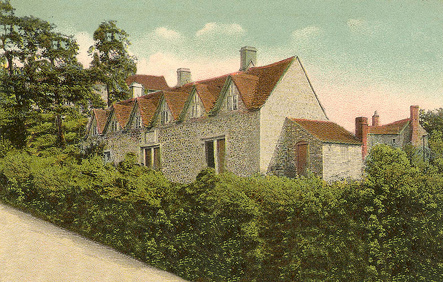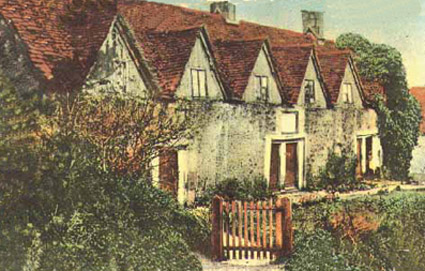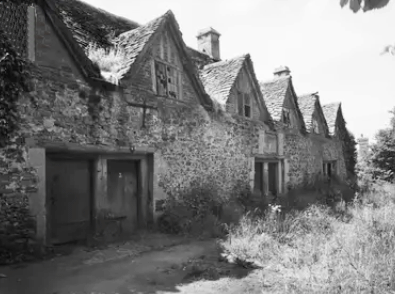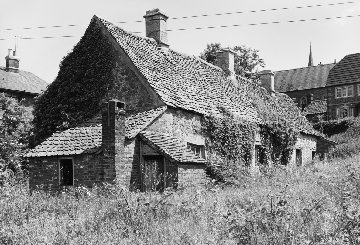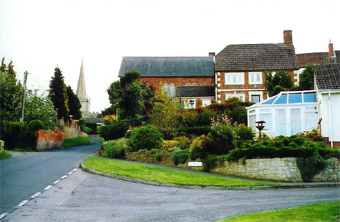|
The Almspeople were to have been born in Bromham or have lived there for at least three years and had to be at least 50 years of age. |
The Almshouses, also known as The College, or Hospital of the Poor stood on the slope of the hill to the south-west of the Church of St. Nicholas Church, at Church Hill, in the village of Bromham. All dwellings faced the road with the occupants of the most easterly houses having to walk past all the others to reach the gardens at the rear with a fresh water spring at the other end of the terrace. The six two-roomed cottages consisted of timber framing, brick walls and stone ground floor, with a room above and below. The plot of ground, containing about an acre, on which they were built was part of the Manor of Bromham. A row of six cottages were built in 1612 and were very much a part of Bromham village, having stood for 352 years before being demolished. The college was founded and governed by Sir
Henry Bayntun (President), who a few months earlier, gave the trustees
(evidently the rector and churchwardens of the parish church of Bromham)
a parcel of land, the almshouses and £20 yearly in rents. Vacancies were to be filled by the founder and his successors, who were to choose one out of four candidates put forward by the trustees. If the elector failed to make a choice within three months the trustees were to fill the vacancy. Sir Henry also intended to give, during his lifetime, two yards and a half of cloth priced at five shillings per yard, at least, to make them gowns and he hoped his successors would continue the gift, however no funds were left for this purpose. The almspeople were required to have been born in the parish or at least have lived there for at least three years. Single people were preferred, but mature married people might be admitted, provided they were at least 50 years of age and they were required to have attended the parish church every Sunday, Wednesday and Friday in their dress and receive the Sacrament four times a year. If there were none eligible, they were to be chosen from other places.
In 1834, Dr.
Starky, the husband of Maria Barbara Bayntun-Rolt, a descendant and
representative of Sir Henry Bayntun, at the time living at Spye
Park House, expressed the belief that Spye Park had been
charged by Sir Henry Bayntun with £20 for the support of six
poor widows in the almshouse. The inmates of the house were six poor widows, chosen by Starky. In 1858 the rector of Bromham declared that John Bayntun-Starky (1834 - 1872), the grandson and heir of the abovementioned Maria Barbara, was disregarding the original statute of the College of the Poor which ordained that the trustees (the rector and churchwardens) should put forward four candidates for each vacancy in the almshouse, from whom the representative of the founder should choose one. There was correspondence on this point between the Commissioners and Mr Starky and the matter was again raised in 1869 when Captain Spicer, the new owner of Spye Park, informed the Commissioners that he was in the habit of choosing the widows for the almshouses. At the time of the Charity Commission of 1901 Captain Spicer was appointing on the nomination of the rector. Captain Spicer kept up the repair of the buildings.
The cottages were eventually demolished in 1964 to make way for modern housing and a new road called Bayntun Close. The first Almshouse was probably situated where the conservatory of the bungalow now stands (pictured below) and ran parallel to Church Hill. So it is likely the six terraced cottages stood where the entrance to Bayntun Close now is. The Methodist Chapel is the red brick building in the middle of the photo and the steeple of the Church of St. Nicholas visible over the roofs. Nothing remains
of these almshouses today, but the above inscription stone was preserved
and later inserted in the floor of the Beauchamp Chapel in the Church
of St. Nicholas in Bromham in memory of Sir Henry Bayntun. This appears
to be the only monument to Sir Henry:
|

